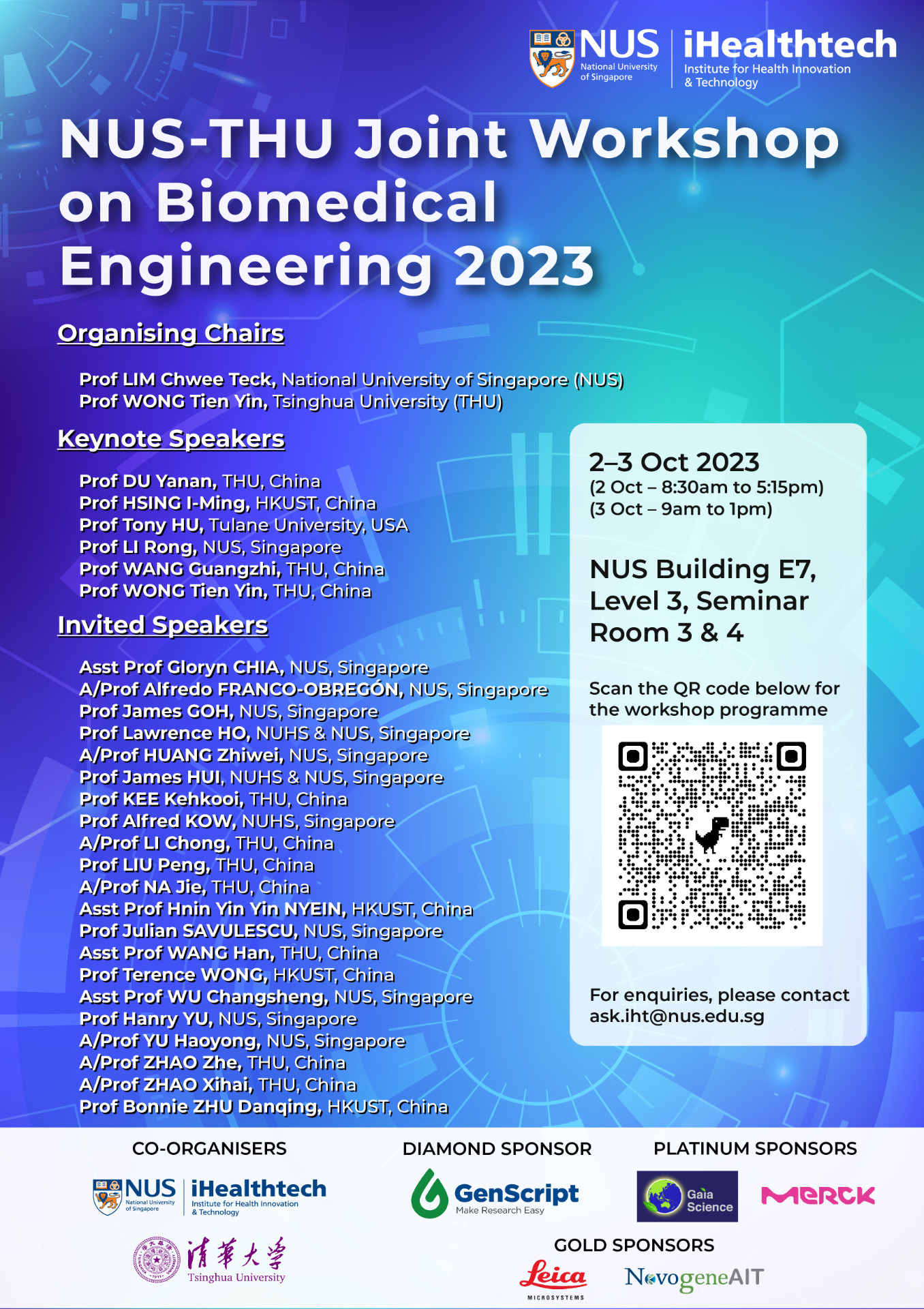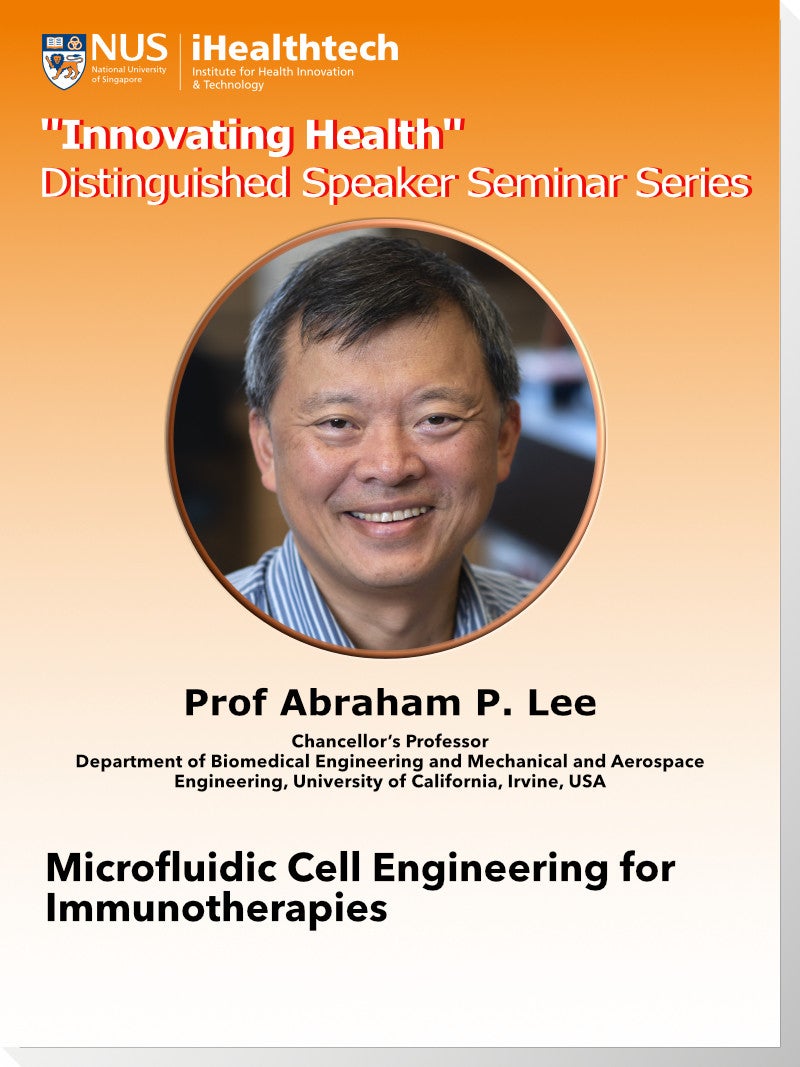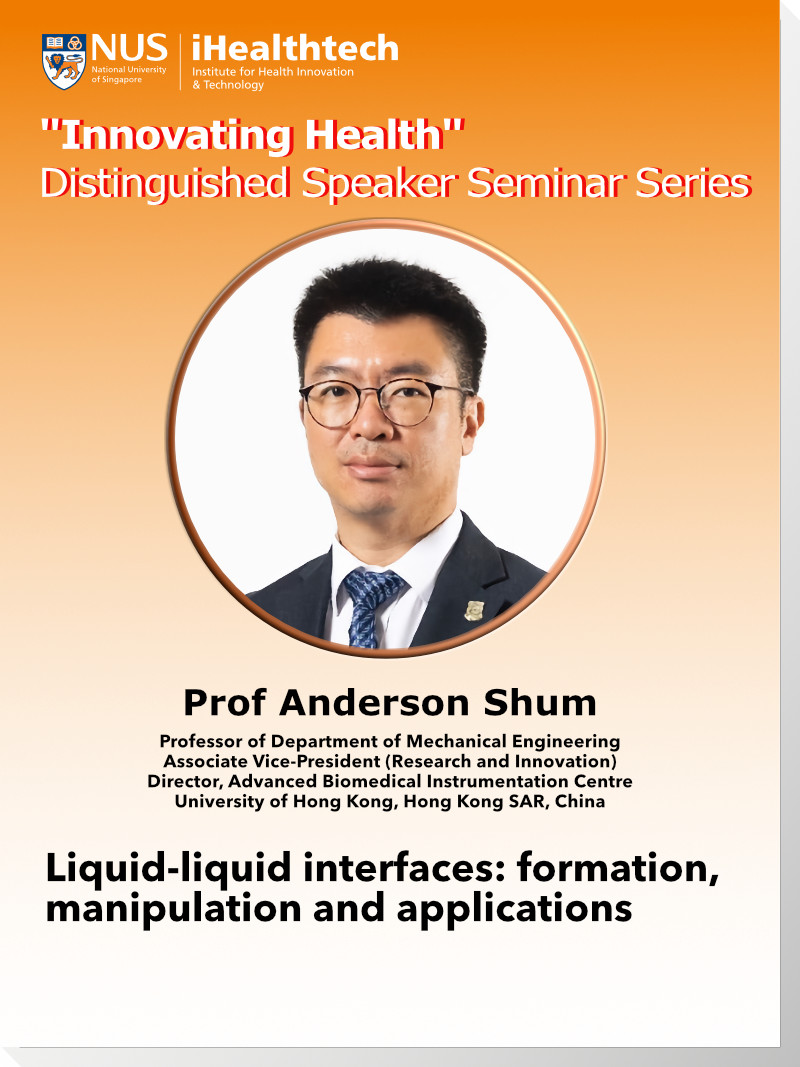NUS-THU Joint Workshop on Biomedical Engineering 2023
We are pleased to invite you to our upcoming NUS – THU JOINT WORKSHOP ON BIOMEDICAL ENGINEERING 2023 on 2 & 3 October. The two-day workshop will bring together world-leading experts, innovators and physicians from the National University of Singapore (NUS), National University Hospital (NUH), Tsinghua University (THU), Tsinghua Medicine and the Hong Kong University of Science and Technology (HKUST). Speakers will cover new concepts and technologies in regenerative and rehabilitative medicine, robotics, biomedical imaging, point-of-care diagnostics, biosensors and artificial intelligence. We hope this workshop will lead to collaboration between researchers from Singapore and China, ultimately contributing to better healthcare.
For any enquiries about the workshop, please email ask.iht@nus.edu.sg.
🗓2 & 3 October 2023
📍NUS, College of Design and Engineering, E7 Engineering in Medicine Building, Level 3, Seminar Rooms 3 & 4 [Map]
🖋️Registration: [https://forms.office.com/r/bNb3726bC8]
Sponsorship Opportunities [PDF]
PAGE CONTENT
- Speakers
- Scientific Programme (Day 1 & Day 2)
- Titles, Abstracts and Speaker Bios
- Poster Session
- Sponsors
ORGANISING CHAIRS
Prof LIM Chwee Teck, National University of Singapore (NUS)
Prof WONG Tien Yin, Tsinghua Universiry (THU)
KEYNOTE SPEAKERS
Prof DU Yanan, THU, China
Prof HSING I-Ming, HKUST, China
Prof Tony HU, Tulane University, USA
Prof LI Rong, NUS, Singapore
Prof WANG Guangzhi, THU, China
Prof WONG Tien Yin, THU, China
INVITED SPEAKERS
Asst Prof Gloryn CHIA, NUS, Singapore
A/Prof Alfredo FRANCO-OBREGÓN, NUS, Singapore
Prof James GOH, NUS, Singapore
Prof Lawrence HO, NUHS & NUS, Singapore
A/Prof HUANG Zhiwei, NUS, Singapore
Prof James HUI, NUHS & NUS, Singapore
Prof KEE Kehkooi, THU, China
A/Prof Alfred KOW, NUHS & NUS, Singapore
A/Prof LI Chong, THU, China
Prof LIU Peng, THU, China
A/Prof NA Jie, THU, China
Asst Prof Hnin Yin Yin NYEIN, HKUST, China
Prof Julian SAVULESCU, NUS, Singapore
Asst Prof WANG Han, THU, China
Asst Prof Terence WONG, HKUST, China
Asst Prof WU Changsheng, NUS, Singapore
Prof Hanry YU, NUS, Singapore
A/Prof YU Haoyong, NUS, Singapore
A/Prof ZHAO Zhe, THU, China
A/Prof ZHAO Xihai, THU, China
Asst Prof Bonnie ZHU Danqing, HKUST, China
SCIENTIFIC PROGRAMME
|
Time (SGT)
|
2 October, Monday (Morning)
|
|
8:30 – 8:45
|
Welcome Address (Chair: Assoc Prof Ali BHAGAT, NUS)
Prof LIU Bin, Deputy President (Research and Technology) of NUS
Prof WONG Tien Yin, Founding Head & Chair Professor of Tsinghua Medicine, THU (Organising Co-Chair)
Prof HSING I-Ming, Director, Master of Science Program in Biomolecular Engineering and Health Informatics (BEHI), HKUST
Prof LIM Chwee Teck, Director, iHealthtech, NUS (Organising Co-Chair)
|
|
Keynote Session (Chair: Assoc Prof Ali BHAGAT, NUS)
|
|
8:45 – 9:15
|
Keynote Talk 1
Life in a Bubble – EV-based Omics Analysis Enabling Personalized Diagnosis
Prof Tony HU, Tulane University
|
|
9:15 – 9:45
|
Keynote Talk 2
Cytoplasmic mechanics in the maturation and aging of mammalian oocytes
Prof LI Rong, NUS
|
|
9:45 – 10:00
|
Keynote Talk 3
AI in the Transformation of Medical Education & Physical Training
Prof WONG Tien Yin, THU
|
|
10:00 – 10:45
|
Panel Discussion: Future of Medicine and Biomedical Engineering in Education & Research
Moderator: Prof LIM Chwee Teck
Panellists:
Prof WONG Tien Yin (THU)
Prof James GOH (NUS)
Prof DU Yanan (THU)
Prof HSING I-Ming (HKUST)
A/Prof Alfred KOW (NUHS, NUS)
|
|
10:45 – 11:00
|
Coffee Break + Poster Viewing
|
|
11:00 – 11:30
|
Keynote Talk 4
Microtissue Engineering Innovates Biomanufacturing & Regenerative Medicine
Prof DU Yanan, THU
|
|
Invited Session 1 (Chair: Dr WANG Han, THU)
|
|
11:30 – 11:50
|
Invited Talk 1
Ethics of ChatGPT
Prof Julian SAVULESCU, NUS
|
|
11:50 – 12:10
|
Invited Talk 2
Engineering simple and robust in vitro cell models for studying NASH
Prof Hanry YU, NUS
|
|
Time (SGT)
|
2 October, Monday (Afternoon)
|
|
12:10 – 12:30
|
Invited Talk 3
Cardiovascular Stem Cell Fate Regulation & Regenerative Medicine
Assoc Prof NA Jie, THU
|
|
12:30 – 12:50
|
Invited Talk 4
Engineering Next-Generation of AAV Vectors for Gene Therapy
Asst Prof Bonnie ZHU Danqing, HKUST
|
|
12:50 – 13:10
|
Invited Talk 5
Exploring alternative neoantigens for development of cancer vaccines
Asst Prof Gloryn CHIA, NUS
|
|
13:10 – 14:00
|
Lunch + Poster Viewing
|
|
Invited Session 2 (Chair: Asst Prof Gloryn CHIA, NUS)
|
|
14:00 – 14:20
|
Invited Talk 6
Constructing in vitro Differentiation Systems to Study Human Germ Cell Development and Reproductive Medicine
Prof KEE Kehkooi, THU
|
|
14:20 – 14:40
|
Invited Talk 7
Magnetism as Medicine
Assoc Prof Alfredo FRANCO-OBREGÓN, NUS
|
|
14:40 – 15:00
|
Invited Talk 8
Neurotechnology-aided Rehabilitation and Personalized Treatment for Stroke Patients
Assoc Prof LI Chong, THU
|
|
15:00 – 15:20
|
Invited Talk 9
Stem cells and exosomes in Orthopaedic Surgery: Bench to bedside
Prof James HUI, NUHS & NUS
|
|
15:20 – 15:40
|
Invited Talk 10
Laser direct-writing CFRPEEK Smart Orthopedic Implant
Assoc Prof ZHAO Zhe, THU
|
|
15:40 – 16:00
|
Coffee Break + Poster Viewing
|
|
Invited Session 3 (Chair: Asst Prof Hnin Yin Yin NYEIN, HKUST)
|
|
16:00 – 16:20
|
Invited Talk 11
Stimulated Raman Scattering Tomography for Label-free Biomolecular and Functional Imaging of Live Cells and Tissue
Assoc Prof HUANG Zhiwei, NUS
|
|
16:20 – 16:40
|
Invited Talk 12
Rapid & Slide-free Tumor Imaging with Virtual Histological Staining Enabled by Deep Learning
Asst Prof Terence WONG, HKUST
|
|
16:40 – 17:00
|
Invited Talk 13
Neurovascular Magnetic Resonance Vessel Wall Imaging: From Technical Development to Clinical Solution
Assoc Prof ZHAO Xihai, THU
|
|
17:00 – 17:15
|
Promotional talk from GenScript (5 mins)
|
|
End of Day 1
|
|
18:00 – 20:00
|
Dinner for Speakers (by invitation only)
|
|
Time (SGT)
|
3 October, Tuesday (Morning)
|
|
Invited Session 4 (Chair: Asst Prof WU Changsheng, NUS)
|
|
9:00 – 9:30
|
Keynote Talk 5
Multimodal Information Perception and Application of Intelligent Surgical Instruments
Prof WANG Guangzhi, THU
|
|
9:30 – 9:50
|
Invited Talk 14
Next Generation Wearable Robotics-A Modular Approach
Assoc Prof YU Haoyong, NUS
|
|
9:50 – 10:10
|
Invited Talk 15
Meeting the Emerging Diagnostic Scenarios with Microfluidics
Prof LIU Peng, THU
|
|
10:10 – 10:30
|
Coffee Break + Poster Viewing
|
|
Invited Session 5 (Chair: Dr ZHAO Zhe, THU)
|
|
10:30 – 11:00
|
Keynote Talk 6
Nucleic Acid Based Bioengineering for Point of Care Applications and Skin-adherent Highly-Stretchable Bioelectronic Patch for Long-term Ambulatory ECG Monitoring
Prof HSING I-Ming, HKUST
|
| 11:00 – 11:20 |
Invited Talk 17
Biomolecular Detection and Quantification enabled by Wearable Non-invasive Biosensors for Health Monitoring
Asst Prof Hnin Yin Yin NYEIN, HKUST |
|
11:20 – 11:40
|
Invited Talk 18
Biosensing Technology-enabled Wearable Medical Devices for Digital Health
Asst Prof WANG Han, THU
|
|
11:40 – 12:00
|
Invited Talk 19
Wireless, Skin-interfaced Optical and Mechano-acoustic Sensors for Deep-tissue Monitoring
Assist Prof WU Changsheng, NUS
|
|
12:00 – 12:20
|
Invited Talk 20
Endoscopic robot – from discovery to clinical adoption
Professor Lawrence HO, NUHS & NUS
|
|
12:20 – 12:30
|
Closing Remarks (Assoc Prof Ali BHAGAT)
|
|
12:30 – 13:00
|
Lunch + Poster Viewing / End of Workshop
|
|
13:00
|
Lab Tours – iHealthtech (30min), MBI @ T-Lab (30min) & MechanoBioEngineering Lab @ T-Lab (30min)
|
ORGANISING CHAIRS
Professor LIM Chwee Teck
National University of Singapore
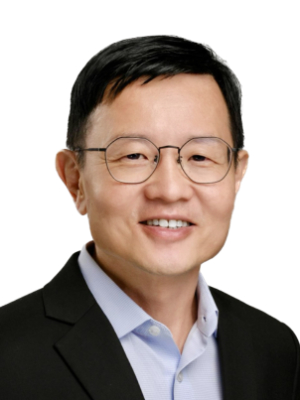
|
Biography
Professor LIM Chwee Teck is the NUS Society Professor and Director of the Institute for Health Innovation and Technology (iHealthtech) at NUS. His research interest is in developing biomedical technologies for healthcare applications. He has co-authored over 470 journal publications, including in Nature, Science, Nature Materials, Nature Reviews Materials, Nature Reviews Bioengineering, Nature Physics, Science Translational Medicine, PNAS, Advanced Materials, etc. and delivered more than 450 plenary/keynote/invited lectures. He is also a serial entrepreneur, having cofounded six companies, with one public listed in 2018. Prof Lim is an elected Fellow of the US National Academy of Inventors, IUPESM, AIMBE, IAMBE, ASEAN Academy of Engineering and Technology, Institution of Engineers Singapore, Academy of Engineering Singapore, and Singapore National Academy of Science. He and his team have garnered over 120 research awards and honours, including Nature Lifetime Achievement Award for Mentoring in Science, Asia’s Most Influential Scientist, Highly Cited Researcher, IES Prestigious Engineering Achievement Award, ASEAN Outstanding Engineering Achievement Award, Asian Scientists 100, Wall Street Journal Asian Innovation Award (Gold) and the President’s Technology Award.
》Back to Programme
|
Professor WONG Tien Yin
Tsinghua University
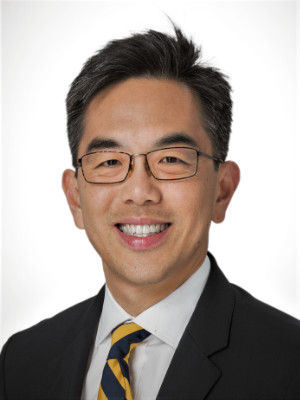
|
How will AI transform the Training of Future Doctors?
With rapid advancements in AI, particularly with the rise of generative AI and AI-powered chatbots, the landscape of medicine and healthcare is on the brink of significant transformation. There are significant constraints in the current medical education model, and there are challenges in educating an expanding pool of medical students with a limited faculty, ensuring uniformity in residency training amidst burgeoning medical knowledge, and the limitations in “’traditional” linear progression from foundational to clinical knowledge acquisition. We suggest an “AI-assisted” and “AI-integrated” model for medical education and physician training, targeting a more universal, accessible, high-quality, and inter-connected educational journey. We advocate the integration of AI as a cornerstone in medical curricula, differentiating between essential knowledge for all physicians, specialized insights for clinician-scientists or medicine-AI facilitators, and mastery-level proficiency for clinician-computer scientists. With the transformative potential of AI in health care and service delivery, it is also poised to reshape the pedagogy of medical education and residency training.
Biography
Prof Wong is an ophthalmologist and physician-scientist who completed medical school at the National University of Singapore (NUS) and has a MPH and PhD in epidemiology from the Johns Hopkins University, USA. In 2022, he took up a new position as Chair Professor and Founding Head of Tsinghua Medicine at Tsinghua University, China. Over the past two decades, Prof Wong has served in multiple leadership positions in Singapore and Australia. His last position was Arthur Lim Professor and Medical Director of the Singapore National Eye Center and concurrently Deputy Group CEO, SingHealth, and Vice-Dean, Duke-NUS Medical School. Prof Wong has also served as Chairs of Departments of Ophthalmology at NUS and University of Melbourne, Australia.
Prof Wong’s research portfolio covers broad medical and public health problems, with a recent interest and focus on digital health and AI. He has published >1,500 papers (h-index >200, multi-year highly cited researcher), given >500 invited named, plenary and symposium lectures, and received >US$100 million in grant funding. Prof Wong has been recognized with multiple international awards, including Arnall Patz Medal (Macula Society), the Jose Rizal Medal (Asia Pacific Academy of Ophthalmology), the Friedenwald Award (ARVO, USA), amongst others. He has received Singapore’s President’s Science as well as the President’s Science and Technology Award. He is an elected international (foreign) member of the US National Academy of Medicine.
》Back to Programme
|
KEYNOTE SPEAKERS
Professor DU Yanan
Department of Biomedical Engineering, School of Medicine, Tsinghua University
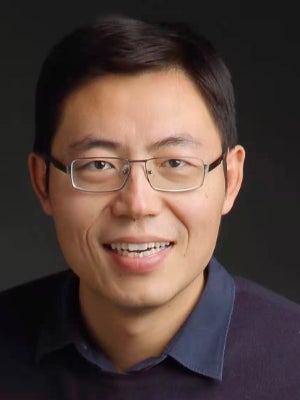
|
Microtissue Engineering Innovates Biomanufacturing and Regenerative Medicine
This talk will introduce the cross-disciplinary concepts and technologies of micro-tissue engineering and how to realize the reconstruction of a 3D bionic cellular microenvironment and the 3D large-scale manufacturing of cells. Meanwhile, how the large-scale manufactured microtissues and their assembly can empower and advance the frontier of downstream regenerative medicine will also be highlighted.
Biography
Dr Du Yanan received his B.Eng. degree in Chemical Engineering from Tsinghua University and PhD in Bioengineering from the National University of Singapore. Dr Du completed his postdoctoral training at Harvard-MIT Division of Health Science and Technology, MIT and Brigham &Women’s Hospital, Harvard Medical School. In 2010, he joined the faculty at the Department of Biomedical Engineering, School of Medicine, Tsinghua University as principal investigator and was promoted to full professor in 2019.
Dr Du’s research team has been innovating in the field of ‘Microtissue Engineering by forging microscale 3D regenerative or fibrotic microniches. The well-designed microniches provide innovative and effective tools and solutions for cell manufacturing, regenerative medicine, and pathology study. Dr Du has published ~100 high-impact papers in journals including Nature Materials, Nature BME, Nature Communications, Science Advances, and PNAS. Meanwhile, He has obtained the grant of 20 patents, including two patents being commercially translated with related products approved as the first cell pharmaceutical excipients by both China CDE and the US FDA. He has also served as an Editorial Board Member of three journals, including Tissue Engineering Part C, ACS Biomaterials Science & Engineering and Cell Regeneration.
》Back to Programme
|
Professor HSING I-Ming
Department of Chemical and Biological Engineering, Hong Kong University of Science and Technology

|
Nucleic Acid Based Bioengineering for Point of Care Applications and Skin-adherent Highly-Stretchable Bioelectronic Patch for Long-term Ambulatory ECG Monitoring
Infectious diseases (e.g., COVID-19) and cardiovascular diseases (CVD) are leading causes of death worldwide. Effective molecular diagnostics technologies (e.g., RT-PCR and RAT) that can be deployed at large scale setting have demonstrated its usefulness for monitoring and mitigation of SARS-CoV-2 pathogens in the community. The recent COVID pandemic has further reminded the healthcare community the imperative needs for wearable and disposable devices and technologies that can achieve non-invasive and continuous monitoring of patients to produce clinically relevant health, realzing the vision of remote ambulatory monitoring and “putting” patients at home.
Leveraging on our expertise in nucleic acid engineering, I will present three patented diagnostics technologies, utilizing thermodynamics-guided of nucleic acid probes and CRISPR-Cas. These prototypical technologies have shown promised results that can be deployed for at home-testing and for large-population community-wide surveillance of viral pathogens. To achieve the vision of remote ambulatory monitoring, I will also present a skin-adherent wearable light-weight ECG bioelectronic path demonstrating a stretchable and conformal monitoring platform that could alleviate the difficulties encountered in a conventional Holter or 12-lead ECG systems. This 12-lead ECG bioelectronic patch has shown promises for the use by healthy individuals or cardiac patients for medical applications in a practical setting.
Acknowledgement: Funding supports from the General Research Fund (GRF# 16302723, CRF# 6107-20G) of Research Grants Council of Hong Kong SAR Government are acknowledged.
Biography
Dr Hsing I-Ming is a Professor and former Head of Department of Chemical and Biological Engineering at the Hong Kong University of Science and Technology (HKUST). He received his BSc from Chemical Engineering at National Taiwan University in 1990 and earned his MSCEP and PhD in 1994 and 1997, respectively, from Chemical Engineering Department at the Massachusetts Institute of Technology (MIT). Right after his PhD training, he started his academic career in the Department of Chemical Engineering at HKUST since Nov. 1997. Subsequently, he was promoted to Associate Professor and Full Professor in 2004 and 2008, respectively. He was the founding Head of Biomedical Engineering Division (BME) for six years in 2011-2017, before BME’s integration with the Department of Chemical and Biomolecular Engineering in July 2017 to form an integrated Department of Chemical and Biological Engineering (CBE). Dr Hsing served as the first Head of CBE from Aug 2017 to July 2023. Dr Hsing’s research interests lie in the interface of molecular biology, reaction engineering, micro/nanofabrication and electrochemistry. Utilizing chemical engineering and molecular engineering principles, his group is interested in nucleic acid engineering and DNA self-assembly for analyte sensing and diagnostic applications for point-of-care testing. His group is also interested in developing organic electrochemical transistors and flexible green bioelectronic and materials for non-invasive and wearable sensing/monitoring biomedical applications. Prof. Hsing serves in the editorial board of several international journals. He also serves as a member at the Research Grants Council of Hong Kong SAR Government, China.
》Back to Programme
|
Professor Tony HU
Department of Biomedical Engineering, Biochemistry and Molecular Biology and Microbiology and Immunology, Tulane University
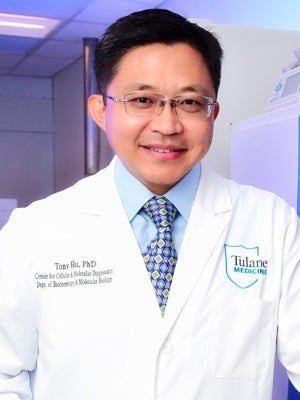
|
Life in a Bubble – EV-based Omics Analysis Enabling Personalized Diagnosis
Diagnostics for infectious and malignant diseases often exhibit poor specificity/sensitivity, hindering early detection and treatment evaluation, but development of improved assays is limited by several challenges, including absence of disease-specific factors, low biomarker concentrations, and interfering factors. We have employed an array of sensitive analytic technology platforms to identify key host-pathogen interactions that influence pathogenesis and applies this information to identify diagnostic and predictive biomarkers that can be applied for personalized medicine to improve patient outcomes. We reported the development and validation of several nanotechnoloy-based assays platforms that can be used to quantify protein and nucleic acid changes in EV-associated protein biomarkers, and which have the capacity to target EVs derived from specific cell populations, including EVs derived from Mtb-infected phagocytes and other cell populations involved in granuloma formation. Candidate biomarkers identified will be analyzed using these platforms and correlated with changes in specific granuloma and systemic cell populations.
Biography
Dr Tony Hu is the Weatherhead Presidential Chair in Biotechnology Innovation and a professor in biochemistry and molecular biology, biomedical engineering, and microbiology at Tulane University. He is also the founding director of the Center for Intelligent Molecular Diagnostics at Tulane School of Medicine.
Considered a pioneer in developing advanced diagnostics for personalized medicine, Dr Hu received his PhD in biomedical engineering from the University of Texas at Austin in 2009. His research focuses on the development of nano or micro-material platforms for multi-omics studies and lab-on-a-chip devices that are designed to enrich biomarker capture from microbial pathogens; enhance biomarker signal; improve the detection sensitivity, specificity, or quantitation of pathogen-derived factors in complex biological samples. His research differs from conventional biomarker discovery and detection research for clinical microbiology in that it employs the special properties of nanomaterials on sensing and sequencing, and data mining algorithms to improve assay performance and reproducibility. This can have a profound impact on the ability to detect and quantitate target low abundance biomarkers in complex mixtures, allowing for the analysis of biomarkers that would otherwise be undetectable.
His work has resulted in publications of over 150 high-impact papers and 14 of his patents have been licensed by US-based or international companies. He is also a co-founder of two biotech startup companies, NanoPin Technologies in Phoenix, AZ and IntelliGenome in New Orelans, LA. Dr Hu’s lab has been consistently supported by NIH, DOD, Gates Foundation, WHO and other funding agencies.
》Back to Programme
|
Professor LI Rong
Director of Mechanobiology Institute (MBI), National University of Singapore

|
Cytoplasmic mechanics in the maturation and aging of mammalian oocytes
Meiotic maturation and fertilization involve two rounds of asymmetric cell divisions generating a large fertilized egg and two small polar bodies. The position and orientation of meiotic spindles are critical for the success of these divisions. The correct spindle positioning is accomplished through migration of the spindle from oocyte center to a subcortical region driven by actin-based forces. We present recent finding on how a critical actin nucleating protein is recruited to the ER membrane surrounding the spindle to initiate actin polymerization and directional spindle movement. Our ongoing research investigates how the dynamic processes during oocyte maturation may be impaired in female reproductive aging.
Biography
Professor Rong Li came from Johns Hopkins University where she served as the Director of the Centre for Cell Dynamics in the Johns Hopkins School of Medicine. She was recruited to NUS in 2019 as the second Director of Mechanobiology Institute (MBI).
Professor Li is a globally respected leader in the study of cellular dynamics and mechanics. Her interdisciplinary research integrates genetics, quantitative imaging, biophysical measurements, mathematical modelling, genomics and proteomics — to understand how eukaryotic cells transmit their genomes, adapt to the environment, and establish distinct organisation to perform specialised functions.
The diverse projects in Professor Rong Li’s lab contribute to two main research thrusts: cell and tissue aging; cellular and organismal adaptation. The study on aging focuses on understanding dynamic changes of crucial cellular components during the aging process and how these changes alter the mechanical functions of cells and tissues. The insights gained will be applied to the development of new methods for prolonging healthy aging and the repair and regeneration of deteriorated functions. The study of adaptation aims to understand the dynamics of genetic and epigenetic determinants of cells and tissues under acute or chronic stress which lead to adaptive behaviors ultimately beneficial or detrimental to the fitness of the organism. A potential application of the discoveries in this area is the prevention of cancer associated with chronic inflammatory diseases.
Lab’s Webpage: https://www.mbi.nus.edu.sg/rong-li/
》Back to Programme
|
Professor WANG Guangzhi
Department of Biomedical Engineering, Tsinghua University

|
Multimodal information perception and application of intelligent surgical instruments
In recent years, intelligent medical devices, such as surgical robots, have made great progress and have become the most concerned high-end medical instruments. Innovative products continue to emerge and expand the application field.
The most important function of the intelligent medical instruments is to effectively assist doctors to complete surgical operations more accurately, safely and efficiently, avoid surgical risks and reduce side effects. Therefore, multimodal information perception and processing has become an indispensable core technology for the development of intelligent surgical instruments.
The report will analyze the role of robot intelligent assistance in image–guided surgery application scenarios, and take our research experience of neurosurgical robots as an example to discuss how to improve the accuracy, convenience and autonomy of surgical robots with the help of multimodal information perception in clinical applications from the perspective of multi-level perception and decision-making.
Biography
Dr Wang Guangzhi entered the Department of Precision Instruments and Mechanology, Tsinghua University in 1979. He obtained bachelor‘s and master’s degrees in 1984 and 1987 respectively. After graduate, he joined the Department of Electronics, Tsinghua University as an teaching assistant, and transferred to the Department of Electrical Engineering, Tsinghua University in 1989. He was promoted to associate Professor in 1993. From 1997~1998, he was a senior visiting scholar at the School of Medicine, Northwestern University, USA. In 2001, he entered the newly established Department of Biomedical Engineering, Tsinghua University and promoted as full Professor in 2003.
Dr Guangzhi Wang is currently a tenured professor at Tsinghua University. He is the deputy director of Steering Committee of Biomedical Engineering Education, Chinese Ministry of Education. Since 2015, he has been elected as the Vice President of Chinese Society of Biomedical Engineering (CSBME), and was elected as the Vice President of Chinese Association of Medical Imaging Technology (CAMIT) since 2018.
Dr Wang Guangzhi’s research interest includes medical image processing, surgical planning and navigation, image-guided therapy and medical robots. He has published more than 150 research papers and obtained more than 30 authorized invention patents. A number of innovative technologies have been utilized in innovative medical device products.
》Back to Programme
|
INVITED TALKS
Assistant Professor Gloryn CHIA
Department of Pharmacy, National University of Singapore | Institute for Health Innovation & Technology

|
Exploring alternative neoantigens for development of cancer vaccines
The paradigm of cancer immunotherapy has been transformed by the emergence of neoantigens as potent targets for tailoring personalized cancer vaccines. However, the limited availability of somatic mutations in the majority of tumor types poses a challenge for effectively harnessing neoantigens. In this context, we explore alternative neoantigens that arise from non-mutational sources, such as epigenetic alterations and splicing changes in tumor cells. Through the analysis of post-transcriptional events in tumour cells, we unveil an unexplored spectrum of neoantigenic diversity that extends beyond traditional mutational landscapes. These alternative sources not only broaden the antigenic repertoire but also address the challenge of tumour types with limited mutational burdens, particularly in developing cancer vaccines.
Biography
Gloryn Chia is an Assistant Professor at the Department of Pharmacy, National University of Singapore, and a Principal Investigator at iHealthtech. She obtained her PhD from the University of Cambridge in Stem Cell Biology, and went on to complete her postdoctoral training at Columbia University under the ASTAR International Fellowship. In 2019, she was awarded the National Research Fellowship, and in 2021, she was named one of two female scientists to receive the L’Oréal Singapore for Women in Science Fellowship. Her current research interests include developing neoantigen vaccines for treating solid tumours and discovering novel immunotherapies to overcome refractory cancers.
》Back to Programme
|
Associate Professor Alfredo FRANCO-OBREGÓN
Department of Surgery, Yong Loo Lin School of Medicine, National University of Singapore
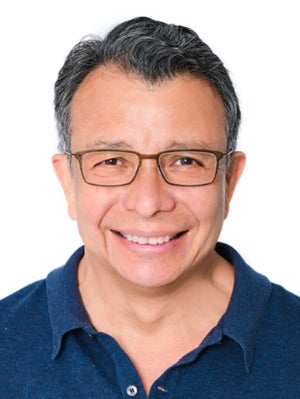
|
|
Magnetism as Medicine
Life, as we know it evolved in an electromagnetic realm. Indeed, biochemistry per se is set to threshold under weak magnetic fields such as those which naturally envelops the Earth. The scientific strategy of the BICEPS (BioIonic Currents Electromagnetic Pulsing Systems) laboratory is to exploit this innate biological imperative in order to promote balanced tissue homeostasis and extend human health. Today I will outline our initial achievements in these endeavours with reference to human frailty and longevity.
Biography
Associate Professor Alfredo Franco-Obregón approaches tissue engineering and regeneration from a biophysical perspective, as an alternative to conventional pharmacological interventions. He is particularly interested in how electromagnetic and mechanical forces drive tissue regeneration. Professor Alfredo Franco-Obregón heads the BICEPS (BioIonic Currents Electromagnetic Pulsing Systems) laboratory under the combined auspices of iHealthtech (Institute for Health Innovation & Technology) of the National University of Singapore (NUS) and the Department of Surgery. He is actively investigating how magnetic fields promote mitochondrial respiration and downstream developmental and survival adaptations via a process known as Magnetic Mitohormesis. His key areas of interest are skeletal muscle development, stem cell biology and cancer and is a thought leader and innovator in the application of electromagnetics and mechanical forces for tissue engineering and regenerative medicine as well as clinical applications concerning human health and longevity.
Professor Alfredo Franco-Obregón is also the founder of QuantumTx Pte. Ltd., a NUS spin-off company, whose aim is to design and fabricate for commercialisation magnetic therapeutic devices for human rehabilitation and regenerative therapies. QuantumTx was awarded the Innovation of the Year Product Winner by the Ageing Asia World Ageing Festival in 2020.
》Back to Programme
|
Professor James GOH
Emeritus Professor, Department of Biomedical Engineering, College of Design and Engineering, National University of Singapore

|
|
Biography
James GOH obtained his PhD in Bioengineering (1982) from the University of Strathclyde, Glasgow, UK. He was the Head, NUS Department of Biomedical Engineering from 2010 to 2019. Prof Goh is the Immediate Past-President, International Union of Physical and Engineering Sciences in Medicine (IUPESM). He was the President of the International Federation of Medical and Biological Engineering from 2015-2018, and the current President of the Biomedical Engineering Society (Singapore). He is Fellow of the Institute of Engineers, Singapore (IES) and chairs IES’ Technical Committee on Biomedical Engineering. He is also a Fellow of the American Institute of Medical and Biological Engineering (AIMBE) and the International Academy of Medical and Biological Engineering (IAMBE) as well as Fellow of the ASEAN Academy of Engineering and Technology (AAET). He is a member of the Biomedical and Health Standards Committee (BHSC) and chairs its Technical Committee on Medical Devices. Prof Goh has been actively involved in organizing international conferences and served on numerous International Advisory Boards and Scientific Committees. He was awarded the IUPESM Award of Merit (2022). Prof Goh has a strong research interest in musculoskeletal research and actively promotes the field of biomedical engineering. He has given numerous invited talks at international and regional conferences. He has published well over 150 international peer review journal papers and served on numerous journal editorial boards.
》Back to Programme
|
Professor Lawrence HO Khek-Yu
National University Health System | Yong Loo Lin School of Medicine, National University of Singapore
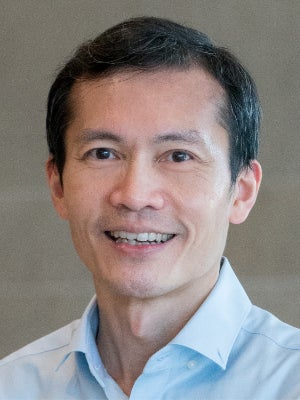
|
|
Endoscopic robot – from discovery to clinical adoption
The main technical difficulties faced by endoscopists are the lack of traction causing suboptimal visualization of the operation field, and lack of triangulation using existing apparatuses. These challenges can be overcome with the use of robotics with its multiple degrees of freedom. We have developed the world’s first endoscopic robot that was successfully used to remove early gastrointestinal cancers. Till date, the Master and Slave Transluminal Endoscopic Robotic (MASTER) System has been clinically validated in human trials for endoscopic submucosal dissection of early gastric and colorectal neoplasia.
However, for the robotic endoscope to be adopted by mainstream clinical practice, its continued relevance to practitioners must be ensured. One such application is in closing gastrointestinal perforation. We have recently developed a new capability of the Master System, allowing it to perform effective suturing. Animal studies successfully demonstrated the feasibility of suturing and knot tying using this new capability. We have also developed a colon support structure that can help to create space in the narrow gastrointestinal lumen. We demonstrated in animal studies that our novel robotic endoscopic suturing device and support structure could be used to suture full-thickness perforations endoscopically.
As the technology is being refined, the use robotic endoscopy will have an established place in the field of endoscopy.
Biography
Professor Ho is Professor of Medicine, National University of Singapore; Senior Consultant, National University Hospital; and Director, Centre for Innovation in Healthcare, National University Health System. Besides being an accomplished endoscopist who has been invited to perform live case demonstrations in numerous international endoscopy workshops, he is an established international key opinion leader, being conferred the honorary International Life Membership of the Society of Gastrointestinal Endoscopy of India, and made Fellow of Japan Gastroenterological Endoscopy Society, to recognize his significant contributions to the field of gastrointestinal endoscopy. Experienced in spearheading collaboration between researchers in Asia, he was the Founding Chairman of the Asian EUS Group. He was also Founding Chair of the Gut & Obesity in Asia (“Go Asia”) Workgroup, and the USA NIH-NCS initiated Asian Barrett’s Consortium.
A proven clinician innovator and experienced entrepreneur, he co-invented the Master and Slave Transluminal Endoscopic Robot (MASTER), which has since been spun-off into the start-up, Endomaster Pte Ltd. He also founded two other start-up companies, Endofotonics Pie Ltd, a molecular AI based realtime diagnostic system, and Endopil Pte Ltd, an ingestible weight loss balloon capsule. He received the Singapore President’s Technology Award in 2012. He has held 6 US-granted patents in medtech products.
He is the immediate past Vice Dean (Research), School of Medicine, National University of Singapore. He was President of Gastroenterological Society of Singapore in 2005. In recognition of his outstanding contributions to the medical profession as a leading expert, the Ministry of Heath Singapore awarded him the prestigious Distinguished Senior Clinician award 2017. He was conferred the National Day Award 2017, Public Administration Medal (Bronze), by the President of the Republic of Singapore, for his distinguished service to public administration. He has published more than 280 peer-reviewed papers.
》Back to Programme
|
Associate Professor HUANG Zhiwei
Department of Biomedical Engineering, College of Design and Engineering, National University of Singapore
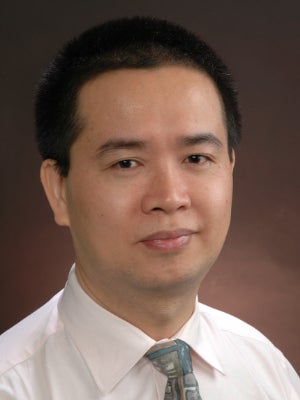
|
Stimulated Raman Scattering Tomography for Label-free Biomolecular and Functional Imaging of Live Cells and Tissue
Stimulated Raman Scattering (SRS) microscopy is an attractive label-free imaging technique in tissue and cells with high biochemical specificity. The conventional SRS microscopy uses the tightly focused Gaussian beams to excite the tissue sample, which suffer from the strong light scattering in turbid media (e.g., tissue) resulting in a very limited penetration depth that unsuits for acquiring volumetric deep tissue image. Here, we present a novel z-scan-free SRS tomography (SRST) technique for rapid functional and biomolecular 3D imaging in frequency-domain. In SRST, the Bessel excitation beams are generated to enhance the imaging penetration depth, while frequency-domain encoding approach enables us to retrieve the depth information without the need of mechanical z-scanning for SRST 3D imaging. SRST provides over 2-fold improvement in penetration depth in highly scattering media as compared to the conventional point-scan SRS microscopy. The z-scan-free optical sectioning ability of optical beatings developed in SRST is universal, which can be readily extended to any other optical imaging modalities for advancing 3D tissue and cells imaging in biological and biomedical systems.
Biography
Dr Zhiwei Huang is Associate Professor in the Department of Biomedical Engineering (BME), College of Design and Engineering at the National University of Singapore (NUS). He is a world-renowned expert in biomedical optics, biophotonics and microscopy imaging. His major research areas are in the fields of biomedical optics, microscopy, Raman spectroscopy and imaging, particularly centering on the development of super-resolution microscopy and nonlinear optical microscopy imaging techniques (e.g., coherent Raman scattering microscopy, multiphoton microscopy) and their applications in biomolecular imaging, as well as the development of novel fiber-optic Raman spectroscopy and endoscopic imaging, enabling early diagnosis and detection of epithelial precancer and cancer at endoscopy. He pioneered in Raman endoscopy and label-free super-resolution bioimaging technologies, and published over 120 peer-reviewed articles in leading journals (e.g., Nature Photonics, Gastroenterology, etc), and delivered over 100 plenary/keynote/invited lectures worldwide. He has filed over 20 US patents with 10 licensed for commercialization. His IMDX technique invented was ranked No.1 among the top 10 medical devices listed in Medica, Germany. He is elective Fellow of SPIE- the international society for optics and photonics.
》Back to Programme
|
Professor James HUI
National University Health System | Department of Orthopaedic Surgery, National University of Singapore

|
Stem cells and exosomes in Orthopaedic Surgery: Bench to bedside
In 2002, Singapore’s Ministry of Health funded a 5-year clinical service trial to repair cartilage defects through human mesenchymal stem cells (hMSCs) as they exhibited high proliferative rates and could develop into other cell types due to their intrinsic multipotential properties. We tested the hypothesis by comparing chondrocytes with MSCs for the repair of chondral defects. Animal experiments performed demonstrated that the joints repaired with implanted chondrocytes showed degenerative changes in the repaired cartilage within 36 weeks, whereas joints repaired by implanted MSCs were still intact at the same time point. In addition, MSCs were found to regenerate not only cartilage but also the underlying subchondral bone.
We pushed for a practical application of the new finding, by investigating a minimally-invasive technique; direct intra-articular injection of mesenchymal stem cells (MSCs) suspended in Hyaluronic Acid (HA), for the treatment of large chondral defects in a porcine model. Results of the MSC-treated group at 12 weeks showed the world’s first definite evidence of improved healing over control groups treated with HA or saline.
We then applied for a phase 1 clinical trial from the Ministry of Health and phase 2/3 randomized controlled trial, to evaluate a novel minimally-invasive technique of cartilage repair in the human knee using autologous MSCs and hyaluronic acid (HA). In 2011, a GMP-compliant facility (TECT lab) was set up to serve as a cell-based therapy centre.
Our clinical trials have shown that at 2 years post-treatment, autologous BMSCs required one less knee surgery, reduced costs, and minimized donor-site morbidity. The long-term follow-up study outcome of these patients were comparable even up to 10 years, and the safety data were recorded, with no tumour formation of the knee for both cell types .
we have also embarked on a parallel path of developing standardized, off-the-shelf and cell-free exosome-based therapeutic for cartilage repair.
Unlike cell-based therapeutics, exosome-based therapeutics are advantageous in that they are small, not viable and could be mass-produced from a clonal immortalized cell source.
We have evaluated the therapeutic efficacy of exosome-infused collagen scaffold in vivo. The combination of MSC exosomes and HA administered at a clinically acceptable frequency of 3 intra-articular injections can promote sustained and functional cartilage repair in a rabbit post-traumatic osteochondral defect model, when compared with HA alone. Through new scientific strategies and clinical applications, we hope to improve patient care, treatment, and quality of life of many patients suffering from knee-related injuries.
Biography
James Hui received his MBBS degree from National University of Singapore in 1990. He received his FRCS (Royal College of Surgeons, Edinburgh UK) in 1994, FAMS (Academy of Medicine, Singapore) in 1999 and Doctor of Medicine (Research, National University of Singapore) in 2008. Dr Hui is currently the Ling Chaw Ming named Professor and Head of Department of Orthopaedic Surgery, National University of Singapore. He was also appointed as Director of National University Tissue Engineering Programme (NUSTEP) and the past president of Asian Cartilage Repair Society, Singapore Orthopaedic Association and ASEAN Paediatric Orthopaedic Association as well as member of the International Orthopaedic Think Tank IPOTT.
Editorial activities:
Associate Editor of JBJS (USA) Essential Surgical Techniques
Journal of Tissue Engineering (Official publication of Tissue Engineering and Regenerative Medicine Society) Sub-section editor, Journal of Orthopedic Surgery (Official publication of Asia Pacific Orthopedic Association) Cartilage (Official publication of the International Cartilage Repair Society)Regards,
》Back to Programme
|
Professor KEE Kehkooi
School of Medicine, Tsinghua University

|
Constructing in vitro differentiation systems to study human germ cell development and reproductive medicine
Germ cells perform many unique and fascinating mechanisms which are vastly different from somatic cells. Understanding mechanisms of human germ cell development is important for building basic knowledge and clinical treatments of infertility, genetic diseases, and tumorgenesis in human reproductive systems. However, genetic and molecular studies of human germ cell development are limited by the ethical and technical constraints to obtain the desired cell type and cell number to conduct molecular and cellular experiments.
Realizing that differentiating human embryonic stem cells (hESCs) to germ cell will provide a novel platform for studying human germ cell development and developing treatment reproductive medicine, we have developed several in vitro differentiation systems to study human germ cells at different developmental stages, including primordial germ cells (PGCs), oocytes and spermatids.
In one recent study, we used in vitro differentiation system of hESCs to PGCs, to elucidate how DAZL, an RNA binding protein, regulates proliferation of human primordial germ cells by direct binding to precursor miRNAs and enhances DICER processing activity. Many RNA-binding proteins (RBPs) and non-coding RNAs are specifically expressed and functional during hPGC developments. However, the roles and regulatory mechanisms of these RBPs and non-coding RNAs, such as microRNAs (miRNAs), in hPGCs remain elusive. In this study, we reported a new regulatory function of DAZL, a germ cell-specific RBP, in miRNA biogenesis and cell proliferation. First, DAZL co-localized with miRNA let-7a in human PGCs and up-regulated the levels of about 100 mature miRNAs, including eight out of nine let-7 family, miR21, miR22, miR125, miR10 and miR199. Purified DAZL directly bound to the loops of precursor miRNAs with sequence specificity of GUU. The binding of DAZL to the precursor miRNA increased the maturation of miRNA by enhancing the cleavage activity of DICER. Furthermore, cell proliferation assay and cell cycle analysis confirmed that DAZL inhibited the proliferation of in vitro PGCs by promoting the maturation of these miRNAs. Evidently, the mature miRNAs up-regulated by DAZL silenced cell proliferation regulators including TRIM71. Moreover, DAZL inhibited germline tumor cell proliferation and teratoma formation. These results demonstrate that DAZL regulates hPGC proliferation by enhancing miRNA processing.
Biography
Dr Kee received his Bachelor’s and Master’s degrees in Biochemistry at Iowa State University in 1997. He studied meiotic recombination during his graduate school at Weill Cornell Medical School and Sloan Kettering Institute in Prof Scott Keeney’s laboratory. After his PhD, he joined Prof Renee Reijo Pera’s lab as a postdoctoral fellow at UCSF and became a research associate at Stanford University in 2007. He started his lab and became a principal investigator at the School of Medicine, Tsinghua University in 2010.
His research team is interested in understanding the molecular mechanisms underlying human germ cell development, initiation of meiosis, and impacts of human germ cells on early embryo development. Their current research projects include developing in vitro models of human germ cell development and studying mutations causing infertility manifested in clinical setting. He has published in Nature, EMBO J, Nature Communications, Human Reproduction Update and other journals reporting many pioneering discoveries and derivation methods in stem cell and reproductive medicine. The in vitro differentiation methods of human pluripotent stem cells to different cell types his team developed have been used in many basic research and translational applications including China space projects to study the effect of microgravity on human germ cell developments.
》Back to Programme
|
Associate Professor Alfred Kow
National University Health System | Department of Surgery, National University of Singapore
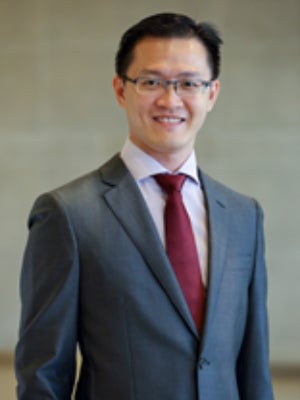
|
Biography
Associate Professor Alfred Kow is a practicing HPB and Liver Transplant surgeon at the National University Hospital Singapore. He is currently the Head of the Hepatobiliary & Pancreatic Surgery at the National University Hospital Singapore. His main area of interest is liver transplantation and minimally invasive HPB surgery. He has pioneered many complex HPB surgeries in Singapore using MIS technique including major laparoscopic hepatectomies, laparoscopic pancreaticoduodenectomy (Whipples’), full laparoscopic ALPPS procedure and laparoscopic liver donor hepatectomy for liver transplantation. He is also the Clinical Director of the MILES program at NUHS (Management and Innovation for Longevity in Elderly Surgical patients), focusing on improving the peri-operative care and outcomes of elderly patients needing surgery in NUHS. In addition, he has been appointed the Associate Chairman of Medical Board (Education) for the National University Hospital Singapore in March 2022. He is also a pioneer in the world in developing mixed reality technology with holographic-guided HPB surgery, including holographic guided laparoscopic liver resection and holographic donor hepatectomy.
He has been actively involved in activities at the International Liver Transplant Society (ILTS) and is the member of the ILTS Education and Scholarship Committee since 2021. He is also the co-lead of the Regional Expansion Advanced Learning project for Southeast Asia and South Asia for the ILTS, focusing on growing the outreach of LT in the regions through education. He is members of a few other committees in the ILTS. Recently, he has also been elected to be the Council member of the Executive Committee of the ILTS for 2023 to 2027. He has received the ILTS REAL award in 2023 for his efforts to grow the knowledge and skills of LT in the Southeast Asian and South Asian regions through educaton. On top of that, he is the study group lead for MIS HPB Surgery at the International Society for Liver Surgeons (ISLS).
In addition to his clinical work, Associate Prof Alfred Kow spends a lot of his time planning medical school curriculum for the Yong Loo Lin School of Medicine in National University of Singapore as the Assistant Dean of Education at the Deanery. He has also received many teaching awards for teaching excellence from the hospital, medical school as well as at the university level (Including the Outstanding Educator Award at the NUS University Awards in 2021). He is also actively involved in surgical training for postgraduate surgical program at the hospital as well as at the Ministry of Health of Singapore. He is also actively involved in developing advanced technology in education using VR, MR and AI with machine learning models in medical training.
Dr Kow has keen interest in research activities involving development of surgical techniques in HPB surgery, liver transplantation and outcomes of surgical treatment for HPB malignancies. Furthermore, he is also actively developing research to help improve surgical education and training for both undergraduate and postgraduate setting. Many of his research work on education aim to understand the art and science behind training the junior doctors to be excellent surgeons for the future. He has published more than 200 peer-reviewed papers and conference articles as well as a few book chapters in the areas of Hepatobiliary surgery and gastroenterology.
》Back to Programme
|
Associate Professor LI Chong
School of Clinical Medicine, Tsinghua University
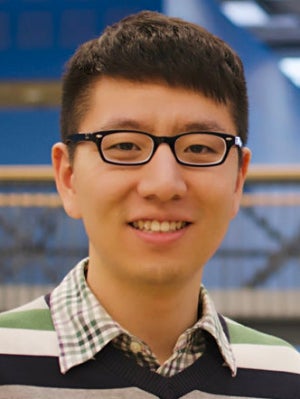
|
Neurotechnology-aided rehabilitation and personalized treatment for stroke patients
Skin is the body’s largest organ. It is responsible for the transduction of a vast amount of information. This conformable, stretchable, self-healable and biodegradable material simultaneously collects signals from external stimuli that translate into information such as pressure, pain, and temperature. The development of electronic materials, inspired by the complexity of this organ, is a tremendous, unrealized materials challenge. However, the advent of organic-based electronic materials may offer a potential solution to this long-standing problem. Over the past decade, we have developed materials design concepts to add skin-like functions to organic electronic materials without compromising their electronic properties. An important discovery was nano-confined polymer semiconductors and conductors. This finding addressed the long-standing challenge of conformational disorder-limited charge transport with polymer electronic materials. It enabled us to introduce various skin-like functions while simultaneously increasing polymer electronic material charge transport ability. The above fundamental understanding further allowed us to develop direct photo-patterning methods and fabrication processes for high-density large-scale soft stretchable integrated circuits. In addition, we developed various soft sensors for continuous measurements, including pressure, strain, shear, temperature, electrophysiological and neurotransmitter sensors. The above sensors and integrated circuits are the foundations for soft bioelectronics and enable a broad range of new tools for medical devices, robotics and wearable electronics.
Biography
Dr Li Chong received PhD from Delft University of Technology, the Netherlands, in 2016 and from Tsinghua University, China, in 2017. He joined the Department of Mechanical Engineering of Tsinghua University in 2017 as a postdoctoral fellow and Assistant Professor in 2019. He is now working as an Associate Professor at the School of Clinical Medicine of Tsinghua University. Dr Chong Li’s research mainly focuses on the direction of biomechatronic engineering for neurorehabilitation, specifically on the design of novel rehabilitation treatment with neurotechnology and personalized treatment to maximize the efficiency of rehabilitation.
Dr Li Chong has been the Principal Investigator of several national research projects and has participated in key projects from NSFC and MOST. He has published more than 30 scientific papers indexed by SCI, including top-tier journals in the fields of rehabilitation, neuroscience, artificial intelligence, etc. Dr Li Chong serves as a Member and Deputy Secretary-general of several academic societies, including the Chinese Society of Biomedical Engineering, the Chinese Association of Assistive Products, and the Chinese Association of Rehabilitation Medicine. He was the only Awardee of the Young Elite Scientist Sponsorship Program by CAST in the Chinese Society of Biomedical Engineering in 2019, and he was also the Awardee of the Beijing Nova Program (Interdiscipline) the same year.
》Back to Programme
|
Professor LIU Peng
Department of Biomedical Engineering, Tsinghua University

|
Meeting the emerging diagnostic scenarios with microfluidics
Sudden outbreaks of large-scale human infectious diseases, exemplified by the COVID-19 pandemic, present a formidable challenge to public health, social and economic stability, and global security. Early, rapid, and accurate diagnosis of infectious diseases is essential for the effective containment of disease spread and improved treatment outcomes. While conventional laboratory-based qPCR methodology played a vital role in the fight against the COVID-19, the emerging diagnostic scenarios, such as population surveillance by pooled testing, on-site rapid diagnosis, and at-home self-testing, obviously cannot be fulfilled by the qPCR alone. In the scenario of pooled testing, dilution-induced false negative is inevitable when using conventional qPCR. Therefore, a more sensitive system is highly demanded for mixing more samples in a single test without sacrificing the sensitivity and the specificity. While both the on-site and the at-home analyses require the truly “sample-in-answer-out” capability, the at-home scenario is more sensitive to the initial instrument costs. Microfluidics has the potential to revolutionize disease diagnosis, offering low-cost, portable, and automated solutions for the pathogen detection, especially in point-of-care testing (POCT). In this presentation, I will report our recent progresses in the development of fully integrated microdevices for nucleic acid testing, including ultra-sensitive microsystem for detecting viruses in aerosols, stand-alone hand-held device for self-testing, etc.
Biography
Dr Peng Liu received his B.Eng. degree in Environmental Engineering and M.S. in Biochemistry and Molecular Biology from Tsinghua University. He then graduated from the University of California, Berkeley, with a PhD in Bioengineering. He completed his postdoctoral training at Sandia National Laboratories, US. Peng Liu joined the Department of Biomedical Engineering, Tsinghua University School of Medicine, as a principal investigator and an associate professor in 2012. Dr Liu’s research interests include: 1) developing fully integrated microfluidic systems for point-of-care diagnosis, forensic short tandem repeat analysis, etc.; 2) developing high-throughput cell microarray platforms for cell manipulation, culture, and analysis.
》Back to Programme
|
Associate Professor NA Jie
Tsinghua University
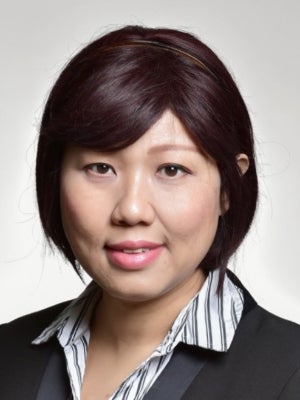
|
Cardiovascular stem cell fate regulation and regenerative medicine
Human pluripotent stem cell (hPSC) differentiation towards cardiovascular and hematopoietic cells can serve as an in vitro model to study the development of the human circulation system. We systematically mapped the single-cell transcriptome and epigenome landscape of cardiac, endothelial, and hematopoietic cell differentiation in 2D chemically defined conditions and 3D microenvironment and identified new regulators for cardiovascular and hematopoietic differentiation. In our recent research, we use hPSC-derived cardiovascular cells to assemble multilineage microtissues and to develop potential new treatments for human ischemic diseases. Dr Jie Na obtained her bachelor’s degree in medicine from the Health Science Center of Peking University in 1997 and PhD in Cell Biology from the University of Virginia, USA in 2002. She did postdoc studying early mouse development in the Wellcome Trust Gurdon Institute in Cambridge University, United Kingdom, from 2002-2005. In 2006, Dr Jie Na was awarded the Stem Cell Career Development Fellowship by the Medical Research Council, UK and started to work on human pluripotent stem cells in the University of Sheffield, UK. In 2010, Dr Jie Na moved to the medical school of Tsinghua University and started her own lab.
Biography
Dr Na’s research fields are early mammalian embryo development, stem cell biology and regenerative medicine. The research focus of Dr Na’s group includes: the epigenetic regulation during human pluripotent stem cells differentiation to cardiovascular and blood lineage cells including cardiomyocytes, blood vessel cells and hematopoietic cells; using CRISPR tools to regulate cell fate, using embryoid and organoid to model embryo development and disease. Dr Na also collaborates with medical doctors and tissue engineers to carry out translational research, using stem cells generated useful cell types for cell-based therapies. Dr Jie Na has published more than 70 papers including corresponding author papers on Nature, Nature Communications, Biomaterials, Stem Cell Reports, Stem Cell Research and Therapy, etc.
》Back to Programme
|
Assistant Professor Hnin Y. Y. NYEIN
Hong Kong University of Science and Technology
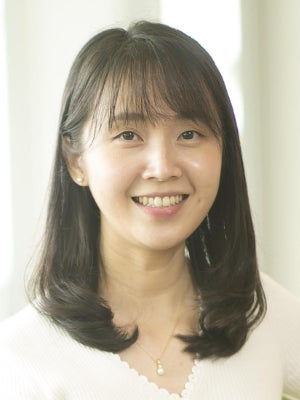
|
Bimolecular Detection and Quantification enabled by Wearable Non-invasive Biosensors for Health Monitoring
In this talk, I will present our recent progresses on the development of wearable biosensors toward remote ambulatory care and routine health monitoring. Today’s healthcare system majorly relies on centralized facilities, leading to hindrance in timely medical diagnosis and treatment. Our wearables aim to address this limitation by enabling non-invasive, continuous detection of clinically meaningful biomarkers in better accessible dermal fluids. These sensors integrate flexible electronics and solid-state electrochemical sensors in a single robust platform such that biochemical analysis can be done effortlessly at the dermal site of sample collection. I will also introduce how we tackle the key challenges in current wearable technology to achieve reliable analyte quantifications comparable to standard measures. These wearables enable dermal fluids a viable mode of health monitoring at the molecular level across activities, whether active or sedentary, and across user groups, whether young or old, healthy or ill. By using the sensors, continuous molecular analysis can be utilized for investigations of body’s endogenous and stimulated response relates to stress, metabolic conditions, and potentially neurological afflictions.
Biography
Dr Nyein received her BSc and PhD (advised by Prof Ali Javey) in Materials Science and Engineering at UC Berkeley. Prior to joining HKUST, she did postdoc training with Prof Tom Soh at Stanford. As a leading author, she has published several pioneer works on wearable sensing technology in major journals, including Nature, Nature Communications, Advanced Materials, Science Advances, and ACS Sensors. She was recognized as an innovator in TR35 Asia Pacific 2021, awarded by MIT Technology Review.
》Back to Programme
|
Professor Julian SAVULESCU
National University of Singapore

|
Ethics of ChatGPT
Julian will discuss some of the ethical issues that the use of Large Language Models (LLMs) such ChatGPT. He will discuss our work using personalised LLMs and discuss potential applications in healthcare. In particular, he will discuss how LLMs can be used to promote patient autonomy and best interests in health care.
Biography
Professor Julian Savulescu is the Chen Su Lan Professor in Medical Ethics at the National University of Singapore, where he directs the Centre for Biomedial Ethics. An award-winning ethicist and moral philosopher, he trained in neuroscience, medicine, and philosophy, going on to hold the Uehiro Chair in Practical Ethics (2002) at the University of Oxford, where he founded the Oxford Uehiro Centre for Practical Ethics in 2003, before moving to NUS in 2022.
He co-directs the Wellcome Centre for Ethics and Humanities. He is Distinguished Visiting Professorial Fellow at Murdoch Children’s Research Institute and Melbourne Law School, where he directs the Biomedical Ethics Research Group.
He is a Fellow of the Australian Academy of Health and Medical Sciences and received an honorary doctorate from the University of Bucharest.
》Back to Programme
|
Assistant Professor WANG Han
Department of Biomedical Engineering, Tsinghua University

|
Biosensing technology-enabled wearable medical devices for Digital Health
To meet the clinical and social needs on chronic disease monitoring and health management in the context of aging society, a multidisciplinary research strategy was undertaken to study biosensing technology for acquisition of clinic-relevant patient health information. Despite recent progress on wearable devices and nanotechnology having demonstrated how real-time monitoring may profoundly change the medical practice of diagnostics and intervention, the clinical utility of such methods remains limited, particularly due to unstable and insensitive sensing interface. In view of this matter, my research on biosensing technology with first principles thinking strives to provide further insights on wearable medical devices to acquire instant and dynamic health information of patients for chronic disease monitoring and routine health management in the era of Digital Health.
Biography
Dr Wang Han received his PhD degree from Texas A&M University in the Department of Electrical Engineering in 2015, and B.S. degree from Tsinghua University in the School of Integrated Circuits in 2009. He thereby conducted his postdoctoral training at Texas A&M University till 2016, and joined the Department of Biomedical Engineering of Tsinghua University in the same year as an Assistant Professor (Research Track) in Professor Jing Cheng’s group. His research interest includes biosensing, microfluidics, and wearable medical devices. Dr Wang’s main research direction is to innovate biosensing interface and sensing modalities through first principles thinking and provide actionable information for medical diagnosis and intervention.
Dr Wang has published 21 peer-reviewed papers in SCI journals including ACS Nano, Biosensors and Bioelectronics, Clinical Chemistry, etc. He has hosted both General Program and Young Scientist Fund of National Natural Science Foundation, and participated in National Key R&D Program of China and other programs. He was the Awardee of Outstanding Young Talents of Beijing in 2020.
》Back to Programme
|
Assistant Professor Terence WONG
Department of Chemical and Biological Engineering, Hong Kong University of Science and Technology

|
Rapid and slide-free tumor imaging with virtual histological staining enabled by deep learning
Rapid and slide-free tissue imaging with histological contrast and minimal tissue preparation has long been a challenging and yet appealing medical pursuit. We have recently proposed a promising and transformative histological imaging method, coined computational high-throughput autofluorescence microscopy by pattern illumination (CHAMP), which can provide rapid and label-free imaging of thick and unprocessed tissues with large surface irregularity at an acquisition speed of 10 mm2/10 s with 1.1-µm lateral resolution. CHAMP images can be subsequently transformed into virtually stained histological images (Deep-CHAMP) through unsupervised learning in a minute. By incorporating a sectioning vibratome with a similar system configuration, three-dimensional histopathology is also feasible.
Biography
Terence Tsz Wai Wong received his B.Eng. and M.Phil. degrees both from the University of Hong Kong in 2011 and 2013, respectively. He studied Biomedical Engineering at the Washington University in St. Louis (WUSTL) and Medical Engineering at the California Institute of Technology (Caltech), under the tutelage of Prof. Lihong V. Wang (member of the National Academy of Engineering and Inventors) for his Ph.D. degree. Right after his Ph.D. graduation from WUSTL, he joined the Hong Kong University of Science and Technology (HKUST) as an Assistant Professor in the Department of Chemical and Biological Engineering (CBE). He is also the Director of the HKUST Research Center for Medical Imaging and Analysis (CMIA).
With the integration of optical/photoacoustic imaging and deep-learning algorithms, his research focuses on developing smart optical and photoacoustic devices to enable translational label-free and high-speed histological imaging, three-dimensional whole-organ imaging, and cancer-targeting deep-tissue imaging. He is the first author, co-author, or corresponding author of over 60 publications in top peer-reviewed journals (including Nature Photonics, Nature Methods, Nature Communications, Science Advances, Advanced Science, etc), conference papers, and book chapters, and has 7 U.S. patents.
》Back to Programme
|
Assistant Professor WU Changsheng
Department of Materials Science and Engineering, College of Design and Engineering, National University of Singapore | Institute for Health Innovation & Technology

|
Wireless, skin-interfaced optical and mechano-acoustic sensors for deep-tissue monitoring
The rapid pace of population ageing and the global outbreak of the COVID-19 pandemic have highlighted the deficiency of medical resources and inefficiency of health systems, thus calling for imminent advancement on biomedical technologies. Current centralized healthcare is mainly offline and curative: the monitoring of patients’ physiological data is intermittent at doctor-centric facilities and care is given upon symptomatic conditions. Meanwhile, the swift advancement in smart materials, wearables, wireless communication, artificial intelligence (AI), and Internet of things, offers a potential paradigm shift in healthcare by launching continuous, pervasive, and personalized digital health solutions, with challenges remaining in advanced monitoring modalities for deep tissues. This talk will cover our recent progress in soft skin-interfaced electronics for continuous monitoring of deep-tissue signals using optical and mechano-acoustic sensors.
Biography
Wu Changsheng is a Presidential Young Professor in the Department of Materials Science and Engineering (MSE) at the National University of Singapore (NUS). He is also a PI in the Institute for Health Innovation and Technology and the N.1 Institute for Health, NUS. He received his PhD in MSE from Georgia Tech and carried out postdoctoral research in the Querrey Simpson Institute for Bioelectronics at Northwestern University. His research focuses on developing wireless wearables and intelligent robots for energy harvesting, biosensing and therapeutic applications, leveraging bioelectronics, materials science, and advanced manufacturing to create solutions for sustainable living and environment.
》Back to Programme
|
Professor Hanry YU
Department of Physiology, Yong Loo Lin School of Medicine, National University of Singapore
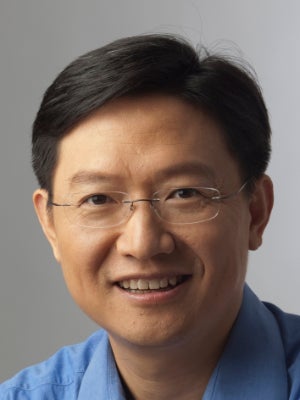
|
Engineering simple and robust in vitro cell models for studying NASH
We have been studying and developing applications relevant to the complex hepatobiliary disease like non-alcohol steatohepatitis (NASH). As we dissect the cellular and niche response to known triggers of NASH progression, we could establish a robust in vitro model with minimal functional module for recapitulating most features of the disease progression and for predictive drug testing. We have cultured organoids using human adult liver stem cells, and co-cultured iPSC-derived Kupffer cells and iPSC-derived Hepatic Stellate cells in adjacent compartments separated by micropillars allowing diffusion-based communications. We demonstrate that all cell types exhibit desirable phenotypes and together with induction factors all features of NASH progression such as macrosteatosis, microsteatosis and true microsteatosis, sustained inflammation linked to early and late ER stress and megamitochondria, hepatocellular ballooning and fibrosis. We have shown the robustness of the model in testing drug candidates used in various clinical trials and high degrees of concurrence with clinical and pre-clinical in vivo findings. Even with this reduced model, it is still too complex to identify drug-able targets rationally which requires causative understanding of the mechanochemical machinery driving the key phenotypic transitions as the disease progresses. I will introduce a simpler model which is being adapted to study the mechanism and identify targets in the relevant disease context.
Biography
Hanry Yu is Professor of Physiology (NUSMed), NUS-College, and Mechanobiology (MBI) at the National University of Singapore; and co-leads a cell therapy manufacturing programme (CAMP) at the MIT research entity (SMART) in Singapore. He integrates biomaterials, tissue mechanobiology and engineering, biomedical optics and AI data analytics into solutions for pharmaceutical, environmental, and recently food industries. He has trained many students and staffs in leading universities in the US and Asia; built several institutions and companies, published >250 papers, delivered >250 invited talks, and consulted for international organisations and agencies.
》Back to Programme
|
Associate Professor YU Haoyong
Department of Biomedical Engineering, College of Design and Engineering, National University of Singapore

|
Next Generation Wearable Robotics-A Modular Approach
With the rapid population aging, wearable Robotics, commonly known as Exoskeleton Robots, are believed to have great potential applications in many areas in both industry and Healthcare. However, the current market size of wearable robotics is still quite small compared with other robotics sectors due to the limitations in design, user experience, and high cost.
At NUS Biorobotics Lab, we are developing a series of wearable robotics with wide range applications. We adopt a modular approach based a set of core technologies and components developed in the lab, which includes compliant actuation, cable mechanism, wearable sensors and learning based movement detection algorithms. We achieved better portability and better human robot interaction due to our compliant actuation and cable transmission and novel mechanism design.
In this talk, we will give a brief introduction of some of our wearable robots and their potential applications.
Biography
Dr Yu Haoyong is an Associate Professor of the Department of Biomedical Engineering at the National University of Singapore. He received his Bachelor’s Degree and Master’s Degree from Shanghai Jiao Tong University and his PhD from Massachusetts Institute of Technology (MIT). His current research interests include biomedical robotics and devices, rehabilitation engineering and assistive technology, service robots, human-robot interaction, intelligent control and machine learning.
》Back to Programme
|
Associate Professor ZHAO Zhe
School of Clinical Medicine, Tsinghua University
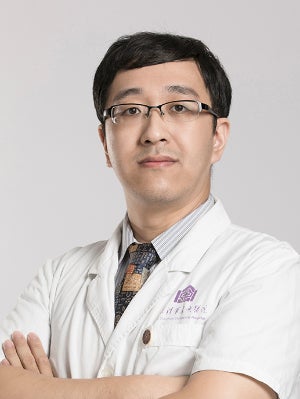
|
Laser direct-writing CFRPEEK Smart Orthopedic Implant
Mechanically close-to-bone carbon-fiber-reinforced poly-ether–ether–ketone (CFR-PEEK)-based orthopedic implants are rising to compete with metal implants, due to their X-ray transparency, superior biocompatibility, and body-environment stability. While real-time strain assessment of implants is crucial for the postsurgery study of fracture union and failure of prostheses, integrating precise and durable sensors on orthopedic implants remains a great challenge. Herein, a laser direct-write technique is presented to pattern conductive features (minimum sheet resistance <1.7 𝛀 sq–1 ) on CRF-PEEK-based parts, which can act as strain sensors. The as-fabricated sensors exhibit excellent linearity (R2 = 0.997) over the working range (0–2.5% strain). All-carbon-based sensors can be written on the complex curved surfaces of CFR-PEEK joints using a portable laser mounted on a six-axis robotic manipulator. A wireless transmission prototype is demonstrated using a Bluetooth module and also a Split Ring Resonator. Such results will allow a wider space to design sensors (and arrays) for detailed loading progressing monitoring and personalized diagnostic applications.
Biography
Dr Zhao Zhe obtained his Medical Doctor degree from Peking Union Medical College in 2010. He currently serves as the Attending Surgeon in the Department of Orthopedics at Beijing Tsinghua Changgung Hospital, as well as an associate professor at the School of Clinical Medicine, Tsinghua University. His main work includes the development of novel orthopaedic implants suitable for the Chinese population. He has participated in the design, testing, and clinical trials of various types of orthopaedic implants. He has also worked on developing sensor-enabled orthopaedic implants, successfully creating a wireless sensor bone plate based on micro-integrated circuits and a laser-written carbon fibre-reinforced poly-ether-ether-ketone-based sensor bone plate. He has published over 40 articles and obtained 8 Chinese patents and 1 US patent.
》Back to Programme
|
Associate Professor ZHAO Xihai
Department of Biomedical Engineering, Tsinghua University

|
Neurovascular Magnetic Resonance Vessel Wall Imaging: From Technical Development to Clinical Solution
Stroke has become one of the leading causes of death worldwide. Disruption of neurovascular vulnerable atherosclerotic plaques is the major etiology of ischemic stroke. Early assessing the vulnerability of neurovascular atherosclerosis is important for accurate diagnosis, decision making and stroke prevention. Magnetic resonance vessel wall imaging has been demonstrated to be capable of comprehensively characterizing plaque features. However, there are still challenges in the receiving coil design, efficiency of acquisition and spatial resolution of imaging sequences, and intelligent image interpretation. This lecture will discuss the advances in imaging sequence development, coil design, and image analysis of neurovascular MR vessel wall imaging.
Biography
Dr Zhao Xihai is a principal investigator and vice director of the Department of Biomedical Engineering at Tsinghua University. Dr Zhao received his doctorate from the Postgraduate School of PLA in 2007 and worked as a research fellow from 2007 to 2010. Dr Zhao joined Tsinghua University in September 2010 and was tenured as an associate professor in 2019. Dr Zhao’s research focus includes technical development and clinical application of cardiovascular magnetic resonance imaging, particularly in atherosclerosis imaging. Dr Zhao has published more than 160 papers in peer-reviewed journals. Dr Zhao is the president of the Society of Magnetic Resonance Angiography (SMRA) and the Annual Meeting Planning Committee (AMPC) member of ISMRM.
》Back to Programme
|
Assistant Professor Bonnie ZHU
Department of Chemical and Biological Engineering, Hong Kong University of Science and Technology

|
Engineering Next-Generation of AAV Vectors for Gene Therapy
Gene therapy, the delivery of genetic material to the cells of a patient for therapeutic benefit, has been increasingly successful over the past decade. The most successful gene delivery vectors are based on adeno-associated viruses (AAV). Although these natural viruses are safe and non-pathogenic, they present several barriers that limit their efficacy in delivery as they have not evolved by nature for human therapeutic applications. Directed evolution, a strategy involves the iterative genetic diversification of a molecule to create a gene pool and functional selection to isolate variants with optimal properties, has thereby emerged as a powerful approach for re-evolving AAVs of novel and improved functions. In parallel, recent advances in deep sequencing technologies allow millions of sequences to be assayed and used for training machine learning (ML) models for the prediction of protein properties. Using the combination of directed evolution and ML-guided design, we have engineered ‘designer’ AAV variants with greatly improved packaging, diversity, and primary human brain infection capabilities. The extension of such integration of new technologies will have broad utility in the development of next-generation novel delivery vectors for therapeutic applications of many diseases in the near future.
Biography
Bonnie Zhu joined the Department of Chemical and Biological Engineering (CBE) as an Assistant Professor in 2023. Bonnie completed her PhD at Stanford University in Bioengineering, supervised by Prof Fan Yang and Prof Sarah Heilshorn. Her research employs materials chemistry, protein engineering, and stem cell approaches to develop models of tissue development that capture the dynamic complexity of cell-ECM interactions. She then continued her training as a CIRM Postdoctoral Fellow and Siebel Scholar at UC Berkeley and UCSF. Her work focuses on using protein engineering and computational approaches to engineer safe and targeted therapeutic gene delivery vectors for the treatment of neurological diseases.
》Back to Programme
|
POSTER SESSION
|
Bio-interfaced Robust Soft Stretchable Hybrid Electronics Enabled by Liquid Metal-based Bilayer Conductor
Shuwen Chen, Shicheng Fan, Jiaming Qi, Chwee Teck Lim
National University of Singapore
Bio-interfaced conformable imperceptible electronics such as soft stretchable wearable and implantable electronics have been highly desired in the diagnosis and treatment of diseases, as well as human-machine interactions. However, it is still challenging to construct stretchable strain-insensitive integrated hybrid electronics due to the incompatibility of soldering and mechanics mismatch between traditional rigid and soft elastic electronics. The motion-induced strain concentration and instability in the soft-hybrid interface and the deformation can also induce microcracks easily, resulting in electrical deterioration.
Here, we introduce a self-assembled amphiphilic bilayer liquid-solid conductor (b-LSC) for the construction of strain-resilient soft-rigid hybrid biosystems, which can not only self-solder the rigid and soft interfaces, withstand the rigorous mechanical strain loading, but also can heal after mechanical damage.
》Back to Programme
|
|
|
Functional Near-Infrared Spectroscopy of English-speaking Adults with Attention-Deficit/Hyperactivity Disorder during a Verbal Fluency Task
Husain SF, Chiang SK, Vasu AA, Goh CP, McIntyre RS, Tang TB, Tran BX, Dang THT, Nguyen TT, Ho RC, Ho CS
National University of Singapore
Objective:
Functional near-infrared spectroscopy (fNIRS) provides direct and quantitative assessment of cortical hemodynamic response. It has been used to identify neurophysiological alterations in medication-naïve adults with attention-deficit/hyperactivity disorder (ADHD). Hence, this study aimed to distinguish both medication-naïve and medicated adults with ADHD from healthy controls (HC).
Method:
75 HCs, 75 medication-naïve, and 45 medicated patients took part in this study. fNIRS signals during a verbal fluency task (VFT) were acquired using a 52-channel system and relative oxy-hemoglobin changes in the prefrontal cortex were quantified.
Results:
Prefrontal cortex hemodynamic response was lower in patients than HCs (p ≤ ≤.001). Medication-naïve and medicated patients did not differ in hemodynamic response or symptom severity (p > .05). fNIRS measurements were not associated with any clinical variables (p > .05). 75.8% patients and 76% HCs were correctly classified using hemodynamic response.
Conclusion:
fNIRS may be a potential diagnostic tool for adult ADHD. These findings need to be replicated in larger validation studies
|
|
|
Magnetically-Induced Muscle Secretome Hosts Anti-Cancer Agents (MIMSA)
Jan Nikolas Iversen
National University of Singapore
Breast cancer is the leading cause of cancer death in women worldwide. Chemotherapy is the mainstream treatment modality for breast cancer, where half of all patients often experience serious adverse events associated with chemotherapy. Hence, companion therapies are being sought to ameliorate physical decline arising from the side effects associated with chemotherapy. Our laboratory has developed a non-invasive pulsed electromagnetic fields (PEMF) platform to improve clinical outcomes in breast cancer when combined with chemotherapy. We hypothesize that PEMF magnetic therapy confers anti-cancer effects, similar to exercise, via the activation of the skeletal muscle secretome. In vitro, muscle secretome harvested from PEMF-exposed muscle cells was found to impair breast cancer cell survival, migration, invasion and clonogenicity. Moreover, blood serum from PEMF-exposed mice diminished breast cancer cell migration and invasion when compared to serum from exercised or control animals. Interestingly, the exposure of naïve muscle cells to magnetically-induced muscle secretome preconditioned them to become more sensitive to subsequent magnetic stimulation, which further enhanced their anti-cancer properties. Overall, PEMF magnetic therapy is a promising therapeutic intervention that not only activates skeletal muscles akin to physical exercise, but also adapts muscles to become more efficient in releasing anti-cancer factors when used regularly.
》Back to Programme
|
|
|
Dissecting Gut-Microbial Consortia Interactions using a Gut Microbiome-on-a-Chip
Jeeyeon Lee, Nishanth Menon, Chwee Teck Lim
National University of Singapore
While the human gut microbiota has a significant impact on health and diseases, our understanding of the precise role of gut microbes, their interrelationship with other microbial species, and their overall impacts on various aspects of human health is hampered by the lack of suitable in vitro co-culture models capable of effectively dissecting their causal and mechanistic relationships. We present a scalable Gut microbiome-on-a-chip that recapitulates and visualizes dynamic gut microbial interfaces, enabling monitoring of microbial behaviors, their interrelationships, and interactions with the gut through high-magnification imaging. The chip features a reproducible three-dimensional biomimetic µGut with key human intestinal structures and functions, including self-generated mucin for creating suitable gut microbial habitat. Incorporating tumorigenic bacteria, enterotoxigenic Bacteroides fragilis (ETBF), into the chip, we demonstrated the attachment, growth, and pathogenic behaviors of ETBF, leading to the µGut disruption and activation of pro-tumorigenic signaling pathways. Pre-treating the µGut with a beneficial gut microbe Lactobacillus spp., hindered ETBF attachment and growth of ETBF through inter-microbial competition, effectively preserving the µGut’s healthy state. The Gut microbiome-on-a-chip holds potential as a valuable tool for exploring unknown roles of gut microbes and gut microbial consortia in human intestinal health and disease.
》Back to Programme
|
|
Melt-Encoded-Tags for Expanded Optical Readout in Digital PCR (METEOR-dPCR) Enables Highly Multiplexed Quantitative Gene Panel Profiling
Dongdong Liu, Lih Feng Cheow
National University of Singapore
Quantitative gene panel profiling is important for early cancer detection, especially for cancers characteristic in copy number variation (CNV). Current approaches for quantitative gene panel profiling are qPCR, digital PCR (dPCR), and next gene sequencing (NGS). qPCR can simultaneously quantify less than 10 genes, digital PCR can simultaneously quantify around 20 genes, both of them are weak in multiplexing for clinical cancer detection. NGS is superior in quantitative and multiplexing, but NGS is expensive and sacrifices more time.
》Back to Programme
|
|
|
|
Contact-free, wireless wearable physiological sensors
Xi Tian, Lichen Bai, Xin Yang, John S. Ho, Changsheng Wu
Existing continuous vital sign monitoring requires wearable sensors with strongly adherent interfaces to the skin. In this work, we propose a novel approach that introduces compact, flexible, wireless sensors capable of continuous physiological signal monitoring without requiring direct skin contact. Our sensing device integrates a wireless sensing component, a 24-GHz transceiver, and a microcontroller unit (MCU) on a flexible printed circuit board (fPCB). The wireless sensing mechanism allows these sensors to be placed without any physical contact to the body, including on eyewear, clothing, and wristbands. Experimental results demonstrate the effectiveness of these non-contact sensors in accurately monitoring vital signs, including heartbeat, respiration, wrist pulse, and temporal pulse.
|
|
Rapid Single-round Pool Testing of Infectious Disease Enabled by Multicolor Digital Melting PCR
Cui Xu, and Lih Feng Cheow
National University of Singapore
Rapid and sensitive diagnosis of infectious disease is key to isolating infected individuals to prevent further community spread. Quantitative reverse-transcription PCR (RT-qPCR) is the gold standard for detecting RNA virus-based infections, but testing a large population with RT-qPCR requires enormous resources and testing capacity. Pooled testing is a promising strategy to test a large population with minimal number of tests, as it involves mixing samples from several individuals and examining them in a single test [1]. However, pooled testing is only useful if disease prevalence is low, because if someone in the pool tests positive each individual would have to be tested separately to locate the infected person therefore incurring additional cost and delay. Ironically, regions with high disease prevalence that are most in need for cost effective and scalable diagnostics cannot benefit from pooled testing.
The advantage of pooled testing can be realized in high prevalence situations if the infected individuals in the pool can be identified in a single round. Here, we report on the Split, Amplify and Melt analysis of Pooled Assay (SAMPA) platform to trace the origins of single viral target molecules from pooled samples in a rapid, high-throughput platform. Leveraging on digital PCR platforms, SAMPA exploits real-time melt curve analysis of multicolor sloppy molecular beacon (SMB) probes across ~37,000 microfluidic partitions simultaneously in a single chip [2] to simultaneously quantify viral load and identify infected individuals in a single-round pooled assay.
The fundamental concepts of SAMPA are: 1) Pre-hybridization of a sample-specific barcode to each RNA sample followed by sample pooling and a single reverse transcription step to produce barcoded cDNA (Figure 1A), 2) Partitioning individual barcoded cDNA in a digital PCR chip, amplify them and identify the sample barcode associated with each cDNA with multicolor melt-curve analysis. Essentially, we can effectively “unmix” the pool to quantify the targets in each constituent sample. We designed and validated 10 unique sample barcodes that can be robustly distinguished through digital melt-curve analysis (Figure 1B-D). Moreover, inclusion of an additional probe can allow determination of viral genotype in pooled assay.
Finally, we performed single-round 8-sample pooled assays with SAMPA for identifying and quantifying DNA, RNA and inactivated virus from SARS-CoV-2 samples and achieved 100% specificity (Figure 2).. The limit of detection of DNA and RNA samples are 5 cp/mL and 90 cp/mL respectively, comparable to RT-PCR assays. Importantly, we demonstrate that digital SAMPA assay can detect and identify all positive cases in N samples with only N/8 assays.
SAMPA is unique among existing nucleic acids amplification tests as it combines the single-molecule resolution of digital PCR with multiplexing capacity of melt-curve analysis to deconvolve and quantify mixed sample pools. The fast turnaround and ease of performing SAMPA is a great advantage in its clinical implementation. We envisage that the SAMPA platform would be of key interest for enabling resource-efficient pooled diagnostics for infectious diseases regardless of disease prevalence.
》Back to Programme
|
|
|
In-vehicle vital sign monitoring with digitally-embroidered metamaterials
Qihang Zeng
National University of Singapore
Continuous in-vehicle physiological monitoring plays a crucial role in improving road safety by enabling the timely detection of driver fatigue and drowsiness. However, achieving reliable contactless health monitoring within enclosed and vibrational vehicular environments is challenging due to motion artifacts and signal interference. In this work, we develop digitally-embroidered metamaterials that provide unobtrusive and continuous in-vehicle physiological monitoring. Fabricated from conductive threads on textiles, our metamaterial sensor can be seamlessly integrated into a harness to conform to body contours and achieves contactless sensing through clothing using radio-frequency wireless signals. In contrast with conventional wireless sensors, our approach exploits metamaterials to guide surface waves and amplify electromagnetic interactions with tissues, allowing reliable capture of physiological motions despite vehicular vibrations and environmental interference. We experimentally demonstrate accurate heartbeat and respiration detection using the embroidered metamaterials in real-world vehicular environments. Our results highlight the potential of metamaterial sensors for driver physiological and mental state monitoring.
》Back to Programme
|
EVENT SPONSORS
